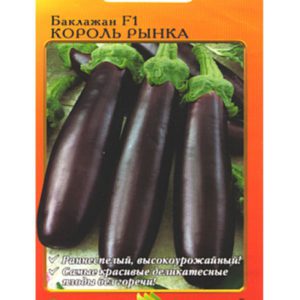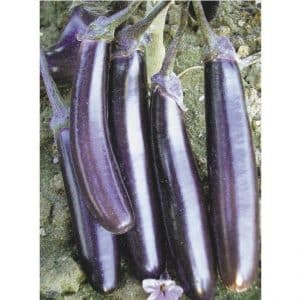Easy-to-care and amazing-tasting eggplant “King of the Market”
Eggplant King of the Market is an unpretentious hybrid that is resistant to diseases and temperature changes. This is the choice of many gardeners who value their work and want to get a high-quality harvest.
In the article we will look at the advantages and disadvantages of eggplant, the secrets of its cultivation, and also share with you reviews from farmers.
Description of culture
The hybrid King of the Market was bred by the agronomic holding "NK Russian Garden" by crossing the frost-resistant eggplant "Gardener's Dream" and the one that is immune to diseases varieties Prince.
Eggplant does not taste bitter, has a rich blue-black color. Suitable for growing in greenhouses and open ground. Among other nightshades, it stands out for its good transportability and rapid adaptation to climate change.
Characteristic features of the hybrid:
- the height of the bush reaches 90 cm when grown in greenhouses and 50 cm in an open area;
- ovary growth from 20 to 25 cm;
- medium-sized leaves with pronounced purple patches on the underside and velvety on the front;
- the stem is covered with villi, thickened towards the root;
- purple flowers with purple veins at the base of the inflorescence;
- the stalks are without thorns, they practically do not bend and break well - the fruits are cut with special scissors or picked by hand.
Reference! This is an early ripening vegetable, but it requires a growth temperature of at least +24 °C, otherwise the eggplants will be distorted.
Fruiting and productivity
The fruits of the hybrid are elongated, cylindrical in shape, have dense white pulp with creamy areas where the seeds are located and a thin peel. The length of eggplants is up to 22 cm with a diameter of 6 cm.
The plant takes two months to fully mature. The yield is high - you can collect up to 10 fruits from one bush. By weight it is approximately 50-60 kg per 10 sq. m.
The keeping quality of the fruit is excellent; special storage conditions are not required.
Germination of seeds

Sowing of seeds begins in late February-early March, depending on the climate of the region. First, the seed is soaked in a weak solution of potassium permanganate to determine germination. Only those grains that have sunk to the bottom are suitable.
The seeds are planted to a depth of 1 cm. It is recommended to plant each plant in a separate box or container with a volume of at least 150 ml - this will make it easier to transplant the crop to a permanent place.
Optimal soil composition:
- 300 g peat;
- 1 kg of humus;
- 2 kg of turf soil.
Before planting the seeds, the soil mixture is poured into pots and heated for 10 days, watered with potassium solution or Fitosporin, and then covered with transparent oilcloth.
Sprout care
Eggplant seeds sprout a week after planting. Seedlings are watered for the first time only when seedlings appear.
Important! It is impossible to fertilize plants - this causes hypervitaminosis, which manifests itself first in the wild growth of seedlings, and then in their death.
At the growth stage, eggplant must be provided with:
- optimal lighting level – daylight hours 12 hours;
- frequent and abundant watering with warm water (sometimes you can spray the seedlings, replacing watering);
- protection from drafts and sudden temperature changes - containers are not placed close to window frames and heating appliances.
Planting and cultivating seedlings
Seedlings are planted in open ground or a greenhouse no earlier than mid-May. Plants have a well-developed, but fragile root system. The bushes are not picked; they are immediately transplanted to a new place along with a lump of earth.
Reference! The seedlings are planted in a square-nest pattern at a distance of at least 50 cm from each other. Frequent planting may reduce yield.
Fertilizers
After planting the plants in a new place, they are fertilized three times during the entire life cycle: 7 days after transplantation, during flowering and during the process of fruit ripening.
For feeding, you can use chemical solutions containing iron, nitrogen, potassium, manganese, phosphorus or organic matter - usually cow manure is used.
Watering
Eggplants are regularly watered with warm water without chlorine and other harmful impurities. The frequency depends on the weather. Plants that lack moisture drop their leaves, lose ovaries and flowers, and the fruits turn yellow. There is a need to maintain a balance here. A lack of moisture leads to the formation of dense areas inside the fruit, an excess of it leads to rotting of the stem and eggplants.
Attention! The soil under the plants is mulched using cut grass or hay.
Diseases and pests
The hybrid King of the Market is resistant to most diseases, but in open ground without proper care, the crop is often attacked by aphids, slugs and Colorado potato beetles. To avoid this, copper sulfate is added to the base of the roots when planting. Flowering eggplants are sprayed with a remedy for the Colorado potato beetle.
Greenhouse conditions
In greenhouses, the hybrid may suffer from black leg, late blight, mosaic, and black rot. Plants affected by rot die fairly quickly if appropriate measures are not taken.
Blackleg or late blight causes the fruit to dry out. They become covered with yellow spots and begin to rot. From mosaic and aphids, the leaves of the hybrid curl up and the plant withers.
You can get a high yield and protect plants from pests if you follow a number of rules:
- sort the seeds before planting;
- monitor the microclimate in the greenhouse;
- inspect eggplants for diseases and pests;
- Water regularly and avoid overwatering.
Application area
Eggplant King of the Market is rich in vitamins and beneficial microelements that improve the functioning of the heart, gastrointestinal tract, and normalize blood circulation. In eastern Asia, ointments are made from the juice of this vegetable to heal wounds.
In our country, eggplants are canned, fried, and steamed. It is best to eat baked fruit - this way all its beneficial properties are preserved.
Advantages and disadvantages
The hybrid King of the Market is rightfully in high demand among summer residents.
The benefits of culture are obvious:
- high productivity;
- pleasant taste without bitterness;
- simple growing conditions;
- standard care;
- resistance to pests, infectious and fungal diseases;
- long-term crop storage;
- universal application: canning And culinary processing.
Disadvantages include curvature of the fruit, but this rarely occurs.
Reviews
There are a lot of reviews about the hybrid, most of them are positive. The crop is valued for its fertility, durability and original taste for eggplants.
Marina, Orel: “I planted the King of the Market eggplant as an experiment. Our summer was hot, we had to water the plants every other day. I collected 12 kg from 3 beds! Children previously did not eat eggplants at all because of the bitterness, but these gobble them up with great appetite.”
Semyon, Tambov: “I am an agronomist by profession, I have my own farm. I am well versed in eggplants and can confidently say that the King of the Market fully lives up to its name. Ripens early, the fruits are of good quality and juicy. Last summer, other eggplant varieties were killed by aphids, but this one survived. It ripens even earlier than zucchini and bears fruit until the end of August. The main thing is an optimal microclimate. During the day it should be +20-25 °C, at night no higher than +15 °C.”
Elena, Novoaleksandrovsk: “I don’t like eggplants, I only grow them because of my husband. Previously I used seeds from the last sowing. The harvest was not particularly pleasing; it was often attacked by spider mites. Last year I bought the King of the Market hybrid. The eggplants did not get sick and grew quickly. Then I thought about where to put so much harvest!”
Conclusion
Eggplant King is profitable to grow both in greenhouses and in open areas. It does not require special care, adapts to any climate and produces a good harvest. You just need to plant the seeds correctly, otherwise the hybrid is unpretentious.